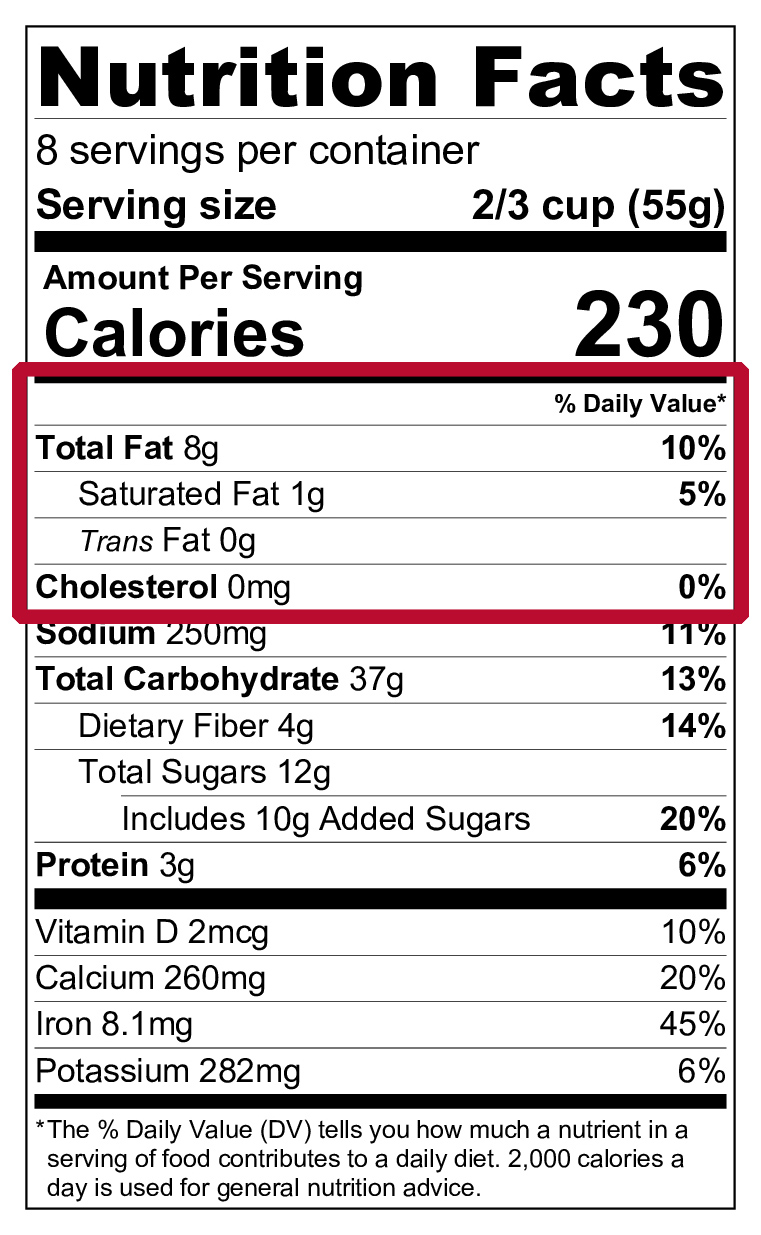An additional author is Candace Tucker, MS, NDTR.
The Nutrition Facts label is a useful tool for making healthier food choices. The label makes it easier to compare products and tells you the nutritional content of the food based on a standard serving size.
What Do Fats Do in Our Bodies?
Our bodies need fat to survive. Fat helps regulate body temperature, protects our organs, makes hormones, and helps our body absorb essential vitamins. The National Academy of Medicine recommends adults obtain 20% to 35% of their calories from fat.
People with diabetes should choose foods lower in saturated and trans fat. Saturated and trans fats both raise LDL (“bad”) cholesterol, increasing your risk for heart attack and stroke. Limit your daily intake of saturated fat, trans fat, and cholesterol to protect your heart.
Suggested Daily Limits

Saturated fat:
- less than 10% of total daily calories, or
- less than 7% if you have heart disease.
Trans fat: 0 g
Cholesterol:
- The Daily Value for cholesterol is less than 300 mg.
- Cholesterol is only found in foods of animal origin, like meat, eggs, seafood, and dairy.
- Consume less high-fat meats and full-fat dairy products, which are also high in saturated fats.
Choose foods low in saturated fat and with no trans fat.
Daily Value
The Daily Value is the recommended amount of a nutrient to consume each day based upon a 2000 calorie reference diet. The % Daily Value is how much a nutrient in a single serving of the food contributes to the Daily Value for that nutrient. The Daily Value is a general guideline to be used for reference. A general rule of thumb is that a nutrient providing 20% or more of the Daily Value is considered high in that nutrient, while a nutrient providing 5% or less of the Daily Value is considered low.
Saturated Fat in Your Diet
| Total calories | 7% saturated fat (amount in grams) | 10% saturated fat (amount in grams) |
|---|---|---|
|
1200 |
9 | 13 |
| 1500 | 12 | 17 |
| 1800 | 14 | 20 |
| 2000 | 16 | 22 |
| 2200 | 17 | 24 |
Beware of Trans Fat
If a food contains less than 0.5 g of trans fat per serving, the label can list the amount of trans fat as 0 g. However, the food may still contain some trans fat.
Trans fats are naturally occurring in small amounts in some meat and dairy products. Historically, the major source of trans fat in the U.S. food supply was industrially produced partially hydrogenated oils. In 2023, the FDA finalized a ruling revoking the use of partially hydrogenated oils as a food ingredient.
References
American Diabetes Association Professional Practice Committee. (2024). Facilitating positive health behaviors and well-being to improve health outcomes: Standards of care in diabetes. Diabetes Care, 47(Supplement_1), S77–S110. https://doi.org/10.2337/dc24-S005
Food Labeling: Trans Fatty Acids in Nutrition Labeling, Nutrient Content Claims, and Health Claims, 68 C.F.R. § 41434 (2003). https://www.federalregister.gov/d/03-17525
Revocation of Uses of Partially Hydrogenated Oils in Foods, 88 C.F.R. § 53764 (2023). https://www.federalregister.gov/d/2023-16725









